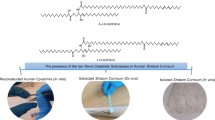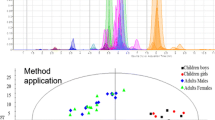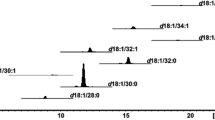Abstract
Introduction
Ceramides play a key role in skin barrier function in homeostatic and pathological conditions and can be sampled non-invasively through stratum corneum collection.
Objectives
To develop a novel UHPLC/Scheduled MRM method for the identification and relative distribution of eleven classes of ceramides, which are separated by UHPLC and determined by their specific retention times. The precise composition of the fatty acid and sphingoid base parts of each individual ceramide is determined via mass fragmentation.
Methods
More than 1000 human and pig ceramides were identified. Three human and minipig ceramide classes, CER[AS], CER[NS] and CER[EOS] have been investigated in depth.
Results
Sphingoid bases were characterized by a prevalence of chain lengths with sizes from C16 to C22, whereas fatty acids were mainly observed in the range of C22–C26. Overall, the ceramide profiles between human and minipig stratum corneum were similar. Differences in the CER[AS] and CER[NS] classes included a more homogeneous distribution of fatty acids (16–30 carbon atoms) in minipig, whereas in human longer fatty acid chains (> 24 carbon atoms) predominated.
Conclusion
The method will be useful for the analysis of healthy and pathological skin in various specie, and the measurement of the relative distribution of ceramides as biomarkers for pharmacodynamic studies.





Similar content being viewed by others
References
Boiten, W., Absalah, S., Vreeken, R., Bouwstra, J., & van Smeden, J. (2016). Quantitative analysis of ceramides using a novel lipidomics approach with three dimensional response modelling. Biochimica et Biophysica Acta, 1861(11), 1652–1661. https://doi.org/10.1016/j.bbalip.2016.07.004.
Eckl, K. M., Tidhar, R., Thiele, H., Oji, V., Hausser, I., Brodesser, S., et al. (2013). Impaired epidermal ceramide synthesis causes autosomal recessive congenital ichthyosis and reveals the importance of ceramide acyl chain length. Journal of Investigative Dermatology, 133(9), 2202–2211. https://doi.org/10.1038/jid.2013.153.
Elias, P. M. (2014). Lipid abnormalities and lipid-based repair strategies in atopic dermatitis. Biochimica et Biophysica Acta, 1841(3), 323–330. https://doi.org/10.1016/j.bbalip.2013.10.001.
Farwanah, H., Pierstorff, B., Schmelzer, C. E. H., Raith, K., Neubert, R. H. H., Kolter, T., et al. (2007). Separation and mass spectrometric characterization of covalently bound skin ceramides using LC/APCI-MS and Nano-ESI-MS/MS. Journal of Chromatography B, 852(1), 562–570. https://doi.org/10.1016/j.jchromb.2007.02.030.
Feingold, K. R., & Elias, P. M. (2014). Role of lipids in the formation and maintenance of the cutaneous permeability barrier. Biochimica et Biophysica Acta (BBA) - Molecular and Cell Biology of Lipids, 1841(3), 280–294. https://doi.org/10.1016/j.bbalip.2013.11.007.
Grösch, S., Schiffmann, S., & Geisslinger, G. (2012). Chain length-specific properties of ceramides. Progress in Lipid Research, 51(1), 50–62. https://doi.org/10.1016/j.plipres.2011.11.001.
Gu, M., Kerwin, J. L., Watts, J. D., & Aebersold, R. (1997). Ceramide profiling of complex lipid mixtures by electrospray ionization mass spectrometry. Analytical Biochemistry, 244(2), 347–356. https://doi.org/10.1006/abio.1996.9915.
Hinder, A., Schmelzer, C. E., Rawlings, A. V., & Neubert, R. H. (2011). Investigation of the molecular structure of the human stratum corneum ceramides [NP] and [EOS] by mass spectrometry. Skin Pharmacology and Physiology, 24(3), 127–135. https://doi.org/10.1159/000322303.
Imokawa, G., Abe, A., Jin, K., Higaki, Y., Kawashima, M., & Hidano, A. (1991). Decreased level of ceramides in stratum corneum of atopic dermatitis: An etiologic factor in atopic dry skin? Journal of Investigative Dermatology, 96(4), 523–526. https://doi.org/10.1111/1523-1747.ep12470233.
Janssens, M., van Smeden, J., Gooris, G. S., Bras, W., Portale, G., Caspers, P. J., et al. (2012). Increase in short-chain ceramides correlates with an altered lipid organization and decreased barrier function in atopic eczema patients. Journal of Lipid Research, 53(12), 2755–2766. https://doi.org/10.1194/jlr.P030338.
Jenkins, B., West, J. A., & Koulman, A. (2015). A review of odd-chain fatty acid metabolism and the role of pentadecanoic acid (c15:0) and heptadecanoic acid (c17:0) in health and disease. Molecules, 20(2), 2425–2444. https://doi.org/10.3390/molecules20022425.
Jennemann, R., Rabionet, M., Gorgas, K., Epstein, S., Dalpke, A., Rothermel, U., et al. (2012). Loss of ceramide synthase 3 causes lethal skin barrier disruption. Human Molecular Genetics, 21(3), 586–608. https://doi.org/10.1093/hmg/ddr494.
Jia, Z. X., Zhang, J. L., Shen, C. P., & Ma, L. (2016). Profile and quantification of human stratum corneum ceramides by normal-phase liquid chromatography coupled with dynamic multiple reaction monitoring of mass spectrometry: Development of targeted lipidomic method and application to human stratum corneum of different age groups. Analytical and Bioanalytical Chemistry, 408(24), 6623–6636. https://doi.org/10.1007/s00216-016-9775-6.
Jungersted, J. M., Hellgren, L. I., Jemec, G. B. E., & Agner, T. (2008). Lipids and skin barrier function: A clinical perspective. Contact Dermatitis, 58(5), 255–262. https://doi.org/10.1111/j.1600-0536.2008.01320.x.
Kezic, S., Novak, N., Jakasa, I., Jungersted, J. M., Simon, M., Brandner, J. M., et al. (2014). Skin barrier in atopic dermatitis. Frontiers in Bioscience (Landmark Edition), 19, 542–556. https://doi.org/10.2741/4225.
Mahl, J. A., Vogel, B. E., Court, M., Kolopp, M., Roman, D., & Nogues, V. (2006). The minipig in dermatotoxicology: Methods and challenges. Experimental and Toxicologic Pathology, 57(5–6), 341–345. https://doi.org/10.1016/j.etp.2006.03.004.
Masukawa, Y., Narita, H., Sato, H., Naoe, A., Kondo, N., Sugai, Y., et al. (2009). Comprehensive quantification of ceramide species in human stratum corneum. Journal of Lipid Research, 50(8), 1708–1719. https://doi.org/10.1194/jlr.D800055-JLR200.
Nagy, K., Sandoz, L., Destaillats, F., & Schafer, O. (2013). Mapping the regioisomeric distribution of fatty acids in triacylglycerols by hybrid mass spectrometry. Journal of Lipid Research, 54(1), 290–305. https://doi.org/10.1194/jlr.D031484.
Pilgram, G. S. K., Vissers, D. C. J., van der Meulen, H., Koerten, H. K., Pavel, S., Lavrijsen, S. P. M., et al. (2001). Aberrant lipid organization in stratum corneum of patients with atopic dermatitis and lamellar ichthyosis. Journal of Investigative Dermatology, 117(3), 710–717. https://doi.org/10.1046/j.0022-202x.2001.01455.x.
Rabionet, M., Bayerle, A., Marsching, C., Jennemann, R., Gröne, H.-J., Yildiz, Y., et al. (2013). 1-O-acylceramides are natural components of human and mouse epidermis. Journal of Lipid Research, 54(12), 3312–3321.
Rabionet, M., Gorgas, K., & Sandhoff, R. (2014). Ceramide synthesis in the epidermis. Biochimica et Biophysica Acta, 1841(3), 422–434. https://doi.org/10.1016/j.bbalip.2013.08.011.
Schulz, H. (2002). Chapter 5 oxidation of fatty acids in eukaryotes. New Comprehensive Biochemistry, 36, 127–150.
Svendsen, O. (2006). The minipig in toxicology. Experimental and Toxicologic Pathology, 57(5–6), 335–339. https://doi.org/10.1016/j.etp.2006.03.003.
t’Kindt, R., Jorge, L., Dumont, E., Couturon, P., David, F., Sandra, P., et al. (2012). Profiling and characterizing skin ceramides using reversed-phase liquid chromatography–quadrupole time-of-flight mass spectrometry. Analytical Chemistry, 84(1), 403–411. https://doi.org/10.1021/ac202646v.
Thakoersing, V. S., van Smeden, J., Mulder, A. A., Vreeken, R. J., Ghalbzouri, A., & Bouwstra, J. A. (2013). Increased presence of monounsaturated fatty acids in the stratum corneum of human skin equivalents. Journal of Investigative Dermatology, 133(1), 59–67. https://doi.org/10.1038/jid.2012.262.
van Smeden, J., & Bouwstra, J. A. (2016). Stratum corneum lipids: Their role for the skin barrier function in healthy subjects and atopic dermatitis patients. In Skin barrier function (Vol. 49, pp. 8–26). Basel: Karger Publishers.
van Smeden, J., Janssens, M., Gooris, G. S., & Bouwstra, J. A. (2014). The important role of stratum corneum lipids for the cutaneous barrier function. Biochimica et Biophysica Acta (BBA) - Molecular and Cell Biology of Lipids, 1841(3), 295–313. https://doi.org/10.1016/j.bbalip.2013.11.006.
Vietzke, J.-P., Brandt, O., Abeck, D., Rapp, C., Strassner, M., Schreiner, V., et al. (2001). Comparative investigation of human stratum corneum ceramides. Lipids, 36(3), 299–304. https://doi.org/10.1007/s11745-001-0721-9.
Weaver, M. L., Grossi, A. B., Schutzsack, J., Parish, J., Logsted, J., Bogh, I. B., et al. (2016). Vehicle systems and excipients used in minipig drug development studies. Toxicologic Pathology, 44(3), 367–372. https://doi.org/10.1177/0192623315613088.
Acknowledgements
The authors are grateful to Charbel Azar and Thierry Alvarez for the collection of minipig stratum corneum samples, to Oana Hulea and Malthide Moyne for the development of UPLC methods, and to Paul Fogel and Michel Poncet for statistical assistance.
Author information
Authors and Affiliations
Contributions
GPL, VA and AG performed all sample analysis. Data analysis and interpretation was carried out in collaboration between GPL, BG and JJV. GPL and JJV wrote the manuscript together. All authors have participed in critical data interpretation and acceptance of the manuscript.
Corresponding authors
Ethics declarations
Conflict of interest
The authors declare that they have no conflict of interest and no conflict of financial interest.
Ethical approval
The work was performed in accordance with the code of ethics of the world medical association (Declaration of Helsinki). Informed consent was obtained for all 10 healthy volunteers enrolled in the study. The study was approved by the local ethics committee (CPP Sud-Méditerranée V, Hopital de Cimiez, NICE, France). For Göttingen minipigs, an equivalent sampling process was performed on the flank of 5 animals. All animal experiments were compliant with the EU Directive 2010/63/EU.
Electronic supplementary material
Below is the link to the electronic supplementary material.
Rights and permissions
About this article
Cite this article
Laffet, G.P., Genette, A., Gamboa, B. et al. Determination of fatty acid and sphingoid base composition of eleven ceramide subclasses in stratum corneum by UHPLC/scheduled-MRM. Metabolomics 14, 69 (2018). https://doi.org/10.1007/s11306-018-1366-4
Received:
Accepted:
Published:
DOI: https://doi.org/10.1007/s11306-018-1366-4




